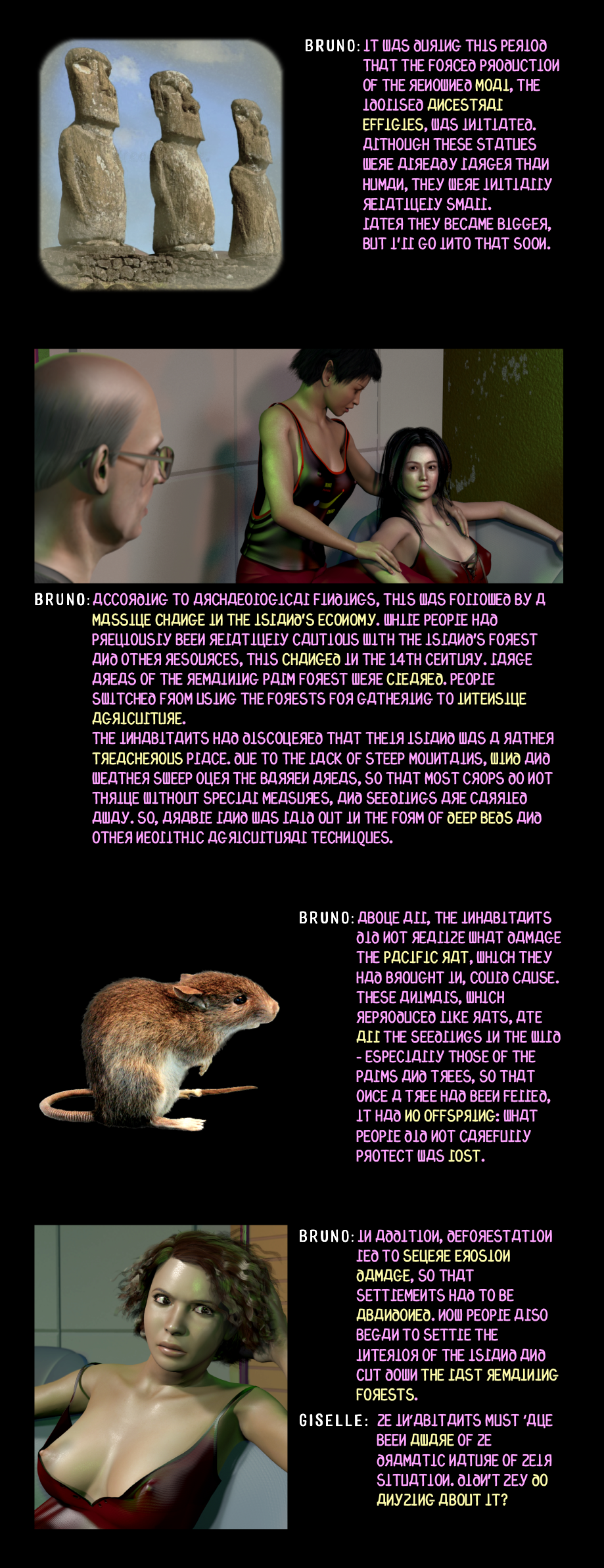Ch6-45
Othosmops on Feb. 13, 2025
(russian):
Panel 1:
BRUNO: It was during this period that the forced production of the renowned Moai, the idolised ancestral effigies, was initiated. Although these statues were already larger than human, they were initially relatively small.
Later they became bigger, but I'll go into that soon.
Panel 2:
BRUNO: According to archaeological findings, this was followed by a massive change in the island's economy. While people had previously been relatively cautious with the island's forest and other resources, this changed in the 14th century. Large areas of the remaining palm forest were cleared. People switched from using the forests for gathering to intensive agriculture.
the inhabitants had discovered that their island was a rather treacherous place. Due to the lack of steep mountains, wind and weather sweep over the barren areas, so that most crops do not thrive without special measures, and seedlings are carried away. So, arable land was laid out in the form of deep beds and other Neolithic agricultural techniques.
Panel 3:
BRUNO: Above all, the inhabitants did not realize what damage the Pacific rat, which they had brought in, could cause. These animals, which reproduced like rats, ate all the seedlings in the wild - especially those of the palms and trees, so that once a tree had been felled, it had no offspring: What people did not carefully protect was lost.
Panel 4:
BRUNO: In addition, deforestation led to severe erosion damage, so that settlements had to be abandoned. Now people also began to settle the interior of the island and cut down the last remaining forests.
GISELLE: Ze in’abitants must ‘ave been aware of ze dramatic nature of zeir situation. Didn't zey do anyzing about it?










jerrie at 7:51AM, Feb. 13, 2025
the only GOOD rat, is a DEAD rat!
Othosmops at 9:11AM, Feb. 13, 2025
Look at this supercute little pacific gnawer! The Polynesians took them with to all their islands as pets that wouldn't die immediately on a long voyage overseas. Even a Polynesian, who has very few resources on a small island, needs a cuddly toy! They just didn't have cats yet. That would have solved the problem.
bravo1102 at 12:40AM, Feb. 13, 2025
The Easter Island branch of Green Peace never really took off. Hard to get people aware by passing out pamphlets when no one can read.
Othosmops at 3:20AM, Feb. 13, 2025
It's not that urgent anymore. Today you can import all kinds of plants. Isolation has been lifted. The European rat has also completely wiped out the population of Pacific rats on the island.
plymayer at 12:15AM, Feb. 13, 2025
;
Othosmops at 3:22AM, Feb. 13, 2025
It is always a big problem if you run down your place of living to such an extent that you can no longer leave it.